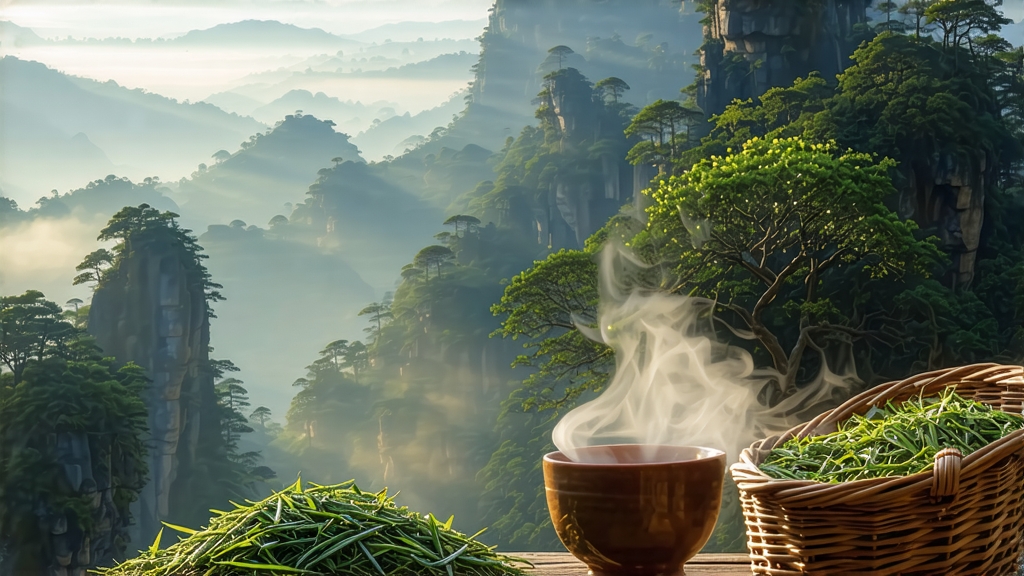
If green tea is China’s gentle watercolor and pu-erh its slow-aged oil painting, then Phoenix Dancong from Guangdong Province is an intricate pen-and-ink drawing scented with mountain wildflowers and molten honey. Known in Mandarin as Fenghuang Dancong—“single-bush” oolong from the Phoenix Mountains—this tea has no exact twin anywhere on earth. Each old-garden tree is propagated by seed, developing a unique aromatic signature that local growers call xiangxing, “the personality of fragrance.” To walk the granite paths of Wudong village at dawn is to move through an invisible library of perfumes: jasmine, ginger flower, almond milk, ripe mango, even the elusive “mountain ghost” note that connoisseurs liken to cool moss after rain.
History: From Imperial Tribute to Global Muse
The first written record appears in the Song-era “Cha Lu” (1045 CE), when the imperial court levied 12 jin of “Baiye” tea from the Phoenix range. By the late Ming, Buddhist monks at Fenghuang Temple were trading Dancong for salt along the maritime Silk Road; Qing archives list 24 aromatic profiles already under cultivation. Republican-era merchants carried the leaf down the Han River to Shantou port, where clipper ships delivered it to Southeast Asian miners craving a taste of home. Today, micro-lots of Wudong Dancong sell at auction in Kuala Lumpur for more per gram than silver, while specialty cafés in Copenhagen and Melbourne serve it in stemmed wine glasses to highlight its layered aromatics.
Terroir: Rock, Mist, and Genetic Chaos
The Phoenix massif rises abruptly from the subtropical delta, its peaks catching monsoon clouds that shed 2,100 mm of rain yearly. Weathered granite soils are so poor that locals joke “a mouse would starve,” yet this stress concentrates aromatic oils. Crucially, the ancient trees are not grafted; every seed-grown individual mutates, producing hundreds of clonal variants now grouped under the umbrella term Dancong. Only those bushes whose cup profile is both distinctive and stable receive a descriptive name—Mi Lan Xiang (honey-orchid), Zhi Lan Xiang (orchid), Xin Ren Xiang (almond), Huang Zhi Xiang (gardenia), and more than eighty others. The highest gardens sit between 800 m and 1,200 m on Wudong, where diurnal swings of 10 °C coax slow leaf growth and a signature mineral “stone bone” texture.
Craft: The Dance of Sun and Fire
Picking begins at 7 a.m. when dew still pearls the leaf; two leaves and a bud are snapped downward to keep the stem tip intact, a silent promise of later elegance. After a brief outdoor withering, the real drama unfolds indoors. Yaoqing—“shake-green”—is a 5- to 8-hour marathon in which the leaves are rhythmically tossed in bamboo drums every 30 minutes, bruising the margins just enough to trigger oxidation while the center stays green. Masters listen for a rustle like distant rain; when the leaf emits the precise scent of ripe peach, firing commences. A 200 °C charcoal roast lasting 2 minutes halts enzymes, followed by repeated low-temperature bakes over the next 48 hours. Traditional wood is longan fruit-tree charcoal, prized for a sweet, clean smoke. The final moisture target is 4 %—any higher and the orchid note will collapse within months; any lower and the coveted “mountain yun” (rhythm of the peak) turns harsh.
Grades and Styles
- Chaoqing (light roast): pale gold liquor, sharp bouquet of white flowers, recommended for drinkers new to Dancong.
- Zhonghuo (medium roast): amber cup, honeyed body with a returning gardenia finish; the most balanced style.
- Zuhuo (heavy charcoal): deep mahogany, cocoa and roasted almond on the palate, favored by Chaozhou elders who pair it with briny snacks.
Within each roast level, elevation defines price. “Wudong Lao Cong” (old bush above 900 m) may come from trees 200–600 years old; their leaves are shorter, serrated like a bird’s claw, and yield a liquor that lingers on the tongue for hours. Lower-elevation “